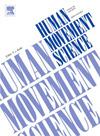在身体重量支持下进行横向运动时的自我选择运动模式。
IF 1.9
3区 心理学
Q4 NEUROSCIENCES
引用次数: 0
摘要
本研究的目的是研究个体在不同的BWS水平和首选速度下横向和向前运动时的代谢消耗、肌肉活动和知觉反应。12名参与者分别在0% BWS、20% BWS和50% BWS条件下,以特定模式的首选速度在下体正压跑步机上进行横向和正向运动。在测试期间测量了摄氧量、肌肉活动、步频、感知运动等级(RPE)和感觉量表。摄氧量受BWS和方向的相互作用影响(p0.05)。我们的观察结果表明,个体自我选择他们的运动速度和跨步频率,并诱导来自下肢的肌肉活动和感知反应在横向运动和向前运动时相似的幅度,而不考虑BWS。本文章由计算机程序翻译,如有差异,请以英文原文为准。
Self-selected movement patterns during lateral locomotion with body weight support
The purpose of this study was to investigate metabolic cost, muscle activity, and perceptual responses during lateral and forward locomotion at different BWS levels at individual's preferred speed. Twelve participants performed lateral and forward locomotion on a lower body positive pressure treadmill at 0 %BWS, 20 %BWS, and 50 %BWS conditions at mode-specific preferred speed. Oxygen uptake, muscle activity, stride frequency, rating of perceived exertion (RPE), and feeling scale were measured during the tests. Oxygen uptake was influenced by the interaction of BWS and direction (P < 0.001). Muscle activity (rectus femoris, biceps femoris, tibialis anterior, and gastrocnemius), stride frequency, and RPE during locomotion at 50 %BWS were averages of 23.7 %, 6.8 %, and 0.8 rankings lower than that of locomotion at 20 %BWS, respectively, regardless of direction (P < 0.05). Feeling scale value during locomotion at 50 %BWS was significantly higher than that of locomotion at 20 %BWS, regardless of direction (P < 0.01). During lateral locomotion, rectus femoris muscle activity was an average of 27.2 % lower and stride frequency was an average of 23.7 % greater than that of forward locomotion, regardless of BWS (P < 0.01). Furthermore, preferred speed during lateral locomotion was an average of 49.9 % lower than that of forward locomotion, regardless of BWS (P < 0.001). However, muscle activity (biceps femoris, tibialis anterior, and gastrocnemius), RPE, and feeling scale were similar between directions, regardless of BWS (P > 0.05). Our observations suggest that individuals self-selected their locomotion speed and stride frequency and induced similar magnitude of muscle activity from the lower extremity and perceptual responses during lateral locomotion and forward locomotion, regardless of BWS.
求助全文
通过发布文献求助,成功后即可免费获取论文全文。
去求助
来源期刊

Human Movement Science
医学-神经科学
CiteScore
3.80
自引率
4.80%
发文量
89
审稿时长
42 days
期刊介绍:
Human Movement Science provides a medium for publishing disciplinary and multidisciplinary studies on human movement. It brings together psychological, biomechanical and neurophysiological research on the control, organization and learning of human movement, including the perceptual support of movement. The overarching goal of the journal is to publish articles that help advance theoretical understanding of the control and organization of human movement, as well as changes therein as a function of development, learning and rehabilitation. The nature of the research reported may vary from fundamental theoretical or empirical studies to more applied studies in the fields of, for example, sport, dance and rehabilitation with the proviso that all studies have a distinct theoretical bearing. Also, reviews and meta-studies advancing the understanding of human movement are welcome.
These aims and scope imply that purely descriptive studies are not acceptable, while methodological articles are only acceptable if the methodology in question opens up new vistas in understanding the control and organization of human movement. The same holds for articles on exercise physiology, which in general are not supported, unless they speak to the control and organization of human movement. In general, it is required that the theoretical message of articles published in Human Movement Science is, to a certain extent, innovative and not dismissible as just "more of the same."
 求助内容:
求助内容: 应助结果提醒方式:
应助结果提醒方式:


